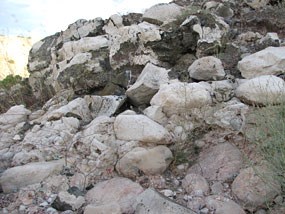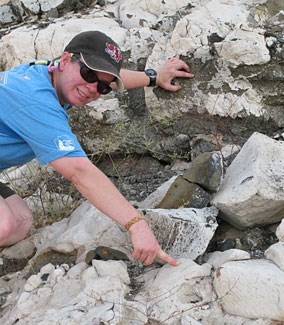
NPS/ALLYSON MATHIS At Sandy Point, a few miles upstream of South Cove in the upper part of Lake Mead, a fixed navigation light helps recreational boaters stay in the channel. This light sits atop a bluff now more than 130 feet above the drought-lowered lake. The cliffs below are coated with the white “bathtub ring” deposit left by higher lake levels. Even though the Sandy Point navigation light now is high above the lake, it still is essential for safe navigation. The Sandy Point basalt outcrop under the navigation light is as important to geologists investigating the origin and evolution of Grand Canyon as the Sandy Point navigation light is to boaters.
This rock outcrop, in conjunction with another rock unit found nearby, provides essential constraints that guide the development of all explanations of how and when the Colorado River established its course through Grand Canyon. The Sandy Point basalt itself looks unremarkable—it is a plain black lava flow like many others found in greater Grand Canyon region. However, volcanic rocks are extremely valuable to geologists because radioactive isotopes they contain decay at measureable rates and can be used as time keepers to determine when the rocks formed. The Sandy Point basalt has been dated at 4.4 million years old by the argon-argon method, the “gold standard” technique for dating young volcanic rocks. 
There are other deposits of Colorado River gravels in the Grand Wash trough, but these deposits themselves do not contain datable material. There are other lava flows as well, but they are younger than the Sandy Point basalt. The Sandy Point basalt’s distinction is that it is the oldest datable rock that is younger than the Colorado River gravels found in the Grand Wash trough. The 4.4-million-year-old Sandy Point basalt gives geologists the minimum age for the Colorado River through Grand Canyon just upstream, but it doesn’t directly answer the question, “how old is Grand Canyon?” Another rock unit nearby also doesn’t directly answer the question of how old Grand Canyon is, but it does tell geologists when the Colorado River was not present in the Grand Wash trough. Grapevine Mesa sits above South Cove. On the drive across Grapevine Mesa, most people will probably notice the Joshua trees rather than the rock that caps the mesa. The Hualapai Limestone looks like another unassuming rock. But, like the Sandy Point basalt, it holds great significance to geologists. The Grand Wash trough formed approximately 15 million years ago with the establishment of the Grand Wash Fault. The Hualapai Limestone formed in lakes on the floor of the Grand Wash trough. It contains no coarse-grained sediment that could have been deposited by the Colorado River, which in turn indicates that the Hualapai Limestone was deposited prior to the establishment of the Colorado River in this area, and presumably the Grand Canyon just upstream.It is difficult for geologists to determine when lake-deposited limestones formed as they typically do not contain minerals that can be used as geologic clocks, and many, such as the Hualapai Limestone, do not contain fossils. Fortunately, the Hualapai Limestone contains volcanic ash beds near its base and near the top of the deposit. Explosive volcanic eruptions can produce thin deposits of volcanic ash that serve as geologic time markers. And volcanic ash beds, like lava flows, can be dated using radiometric techniques. The ash bed near the base of the Hualapai Limestone is measured to be 11 million years old by the argon-argon method and the ash bed near the top is six million years old. This data from the Hualapai Limestone and the Sandy Point basalt tell geologists two critical pieces of information:
Thus, the age of the Colorado River, and therefore, the Grand Canyon is bracketed between six and 4.4 million years old. Geology, like all sciences, is an attempt to discover, understand, and explain what we see in the natural world. Scientific theories must be constrained by facts such as the highly precise age determinations on the Sandy Point basalt and the ash beds within the Hualapai Limestone. Any model for the origin and evolution of the landscape that we know today as Grand Canyon must explain the absence of the Colorado River just below the end of Grand Canyon at the Grand Wash Cliffs six million years ago, and its presence by 4.4 million years ago. The origin and evolution of Grand Canyon is complex, and the Colorado River likely evolved from pre-existing drainages to find its current course. A variety of other geologic evidence indicates that other former rivers flowing in different directions carved canyons in the pre-Grand Canyon landscape. The Colorado River did not cut Grand Canyon by merely incising into a flat, featureless plain.
NPS PHOTO BY MICHAEL QUINN A great deal of exciting scientific research exploring the origin of the Grand Canyon landscape is underway. A number of technical articles in scientific publications each year give further insight into the long and complex history of today’s canyon landscape. Yet these theories about the origin of the Colorado River must be informed the Sandy Point basalt and Hualapai Limestone just as boaters need to use the navigation light atop the Sandy Point basalt to safely find their way on the waters of Lake Mead. Allyson Mathis is the science and education outreach coordinator for the Division of Science and Resource Management at Grand Canyon National Park.Return to the Canyon Sketches Home Page |
Last updated: February 15, 2018
